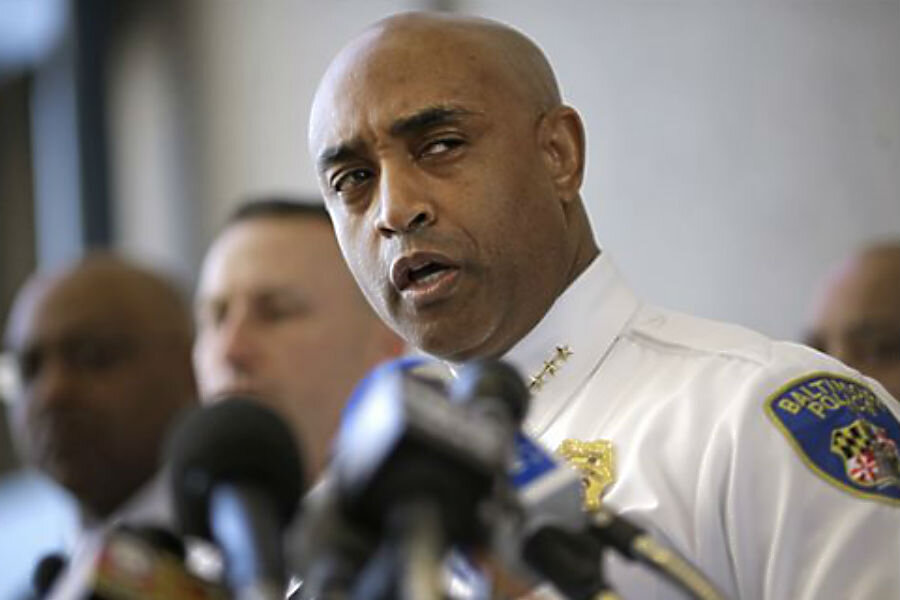Freddie Gray protests in Baltimore: Why so big?
Loading...
| Baltimore
Protesters who've been holding near-daily demonstrations this week over the death of Freddie Gray are promising their biggest march yet a day after the Baltimore Police Department acknowledged that it failed to get him the medical attention he needed after his arrest.
Protesters vowed to "shut down" the city by marching through the streets and snarling traffic. The president of a black lawyers' group predicted thousands of people would turn out for the demonstration, when good weather is forecast and the Baltimore Orioles host the Boston Red Sox.
"Things will change on Saturday, and the struggle will be amplified," said Malik Shabazz of Black Lawyers for Justice. "It cannot be business as usual with that man's spine broken, with his back broken, with no justice on the scene."
Shabazz has demanded the arrest of six officers involved in the arrest of Gray, who died Sunday a week after suffering a spinal injury while in police custody.
The officers are suspended with pay and under criminal investigation by their own department. The U.S. Justice Department is reviewing the case for any civil rights violations, and Gray's family is conducting their own probe.
Late Friday, Deputy Commissioner Kevin Davis said Gray, 25, should have received medical attention at the spot where he was arrested — before he was put inside a police transport van handcuffed and without a seat belt, a violation of the Police Department's policy.
Gray, who is black, was arrested April 12 after he made eye contact with officers and ran away, police said. Officers held him down, handcuffed him and loaded him into the van. While inside, he became irate and leg cuffs were put on him, police have said.
Gray asked for medical help several times, beginning before he was placed in the van. After a 30-minute ride that included three stops, paramedics were called.
Authorities have not explained how or when Gray's spine was injured.
Commissioner Anthony Batts said it was possible Gray was hurt before the van ride or during a "rough ride" — where officers hit the brakes and take sharp turns to injure suspects in the back of vans.
"We know he was not buckled in the transportation wagon as he should have been. There's no excuse for that, period," Batts said. "We know our police employees failed to give him medical attention in a timely manner multiple times."
Earlier Friday, Mayor Stephanie Rawlings-Blake said she has many questions.
"I still want to know why the policies and procedures for transport were not followed," she said. "I still want to know why none of the officers called for immediate medical assistance despite Mr. Gray's apparent pleas.
"The one thing we all know is because of this incident a mother has to bury their child and she doesn't even know exactly how or why this tragedy occurs — only that this occurs while her child was in police custody," the mayor said. "This is absolutely not acceptable, and I want answers."
Rawlings-Blake expects the results of the Police Department's investigation to be turned over to prosecutors in a week, and they will decide whether any criminal charges will be filed or whether to put the case before a grand jury. There is no timetable for when that will happen.
The leader of a group of local ministers called on Batts to resign immediately.
"It seems that no one in the Police Department can explain what happened," said the Rev. Alvin Gwynn Sr., president of the Interdenominational Ministerial Alliance of Baltimore.
He said the Police Department is "in disarray" and Batts has shown a "lack of viable leadership capabilities."
The mayor appeared to back the police commissioner at her own news conference, and Batts defended his record, saying he was brought on in 2012 to reform the department. Since then, he said he has fired 50 employees and reduced the number of officer-involved shootings and excessive force complaints.
The Rev. Frank Reid of Bethel African Methodist Episcopal Church in Baltimore, who met with Rawlings-Blake on Friday, said he wants to believe the Police Department's investigation will be transparent.
"I want to take them at their word, but the purpose of being here today is to not only to let the city know but the Police Department know that we're going to hold them accountable," Reid said. "This is not going to go away. ... Business as usual is no longer acceptable. This is all too frequent. It's a historic issue, and we want to stop it now."







